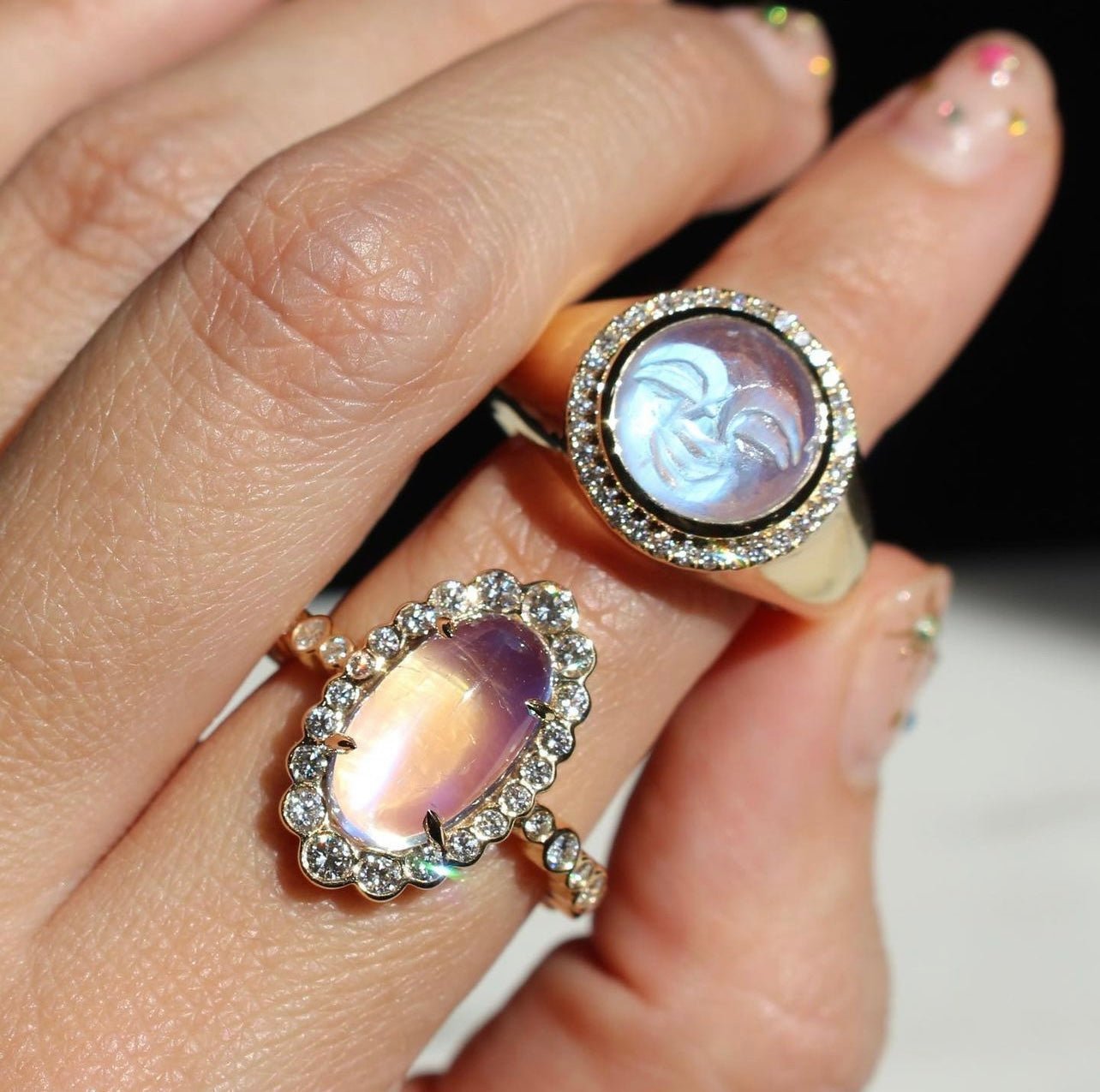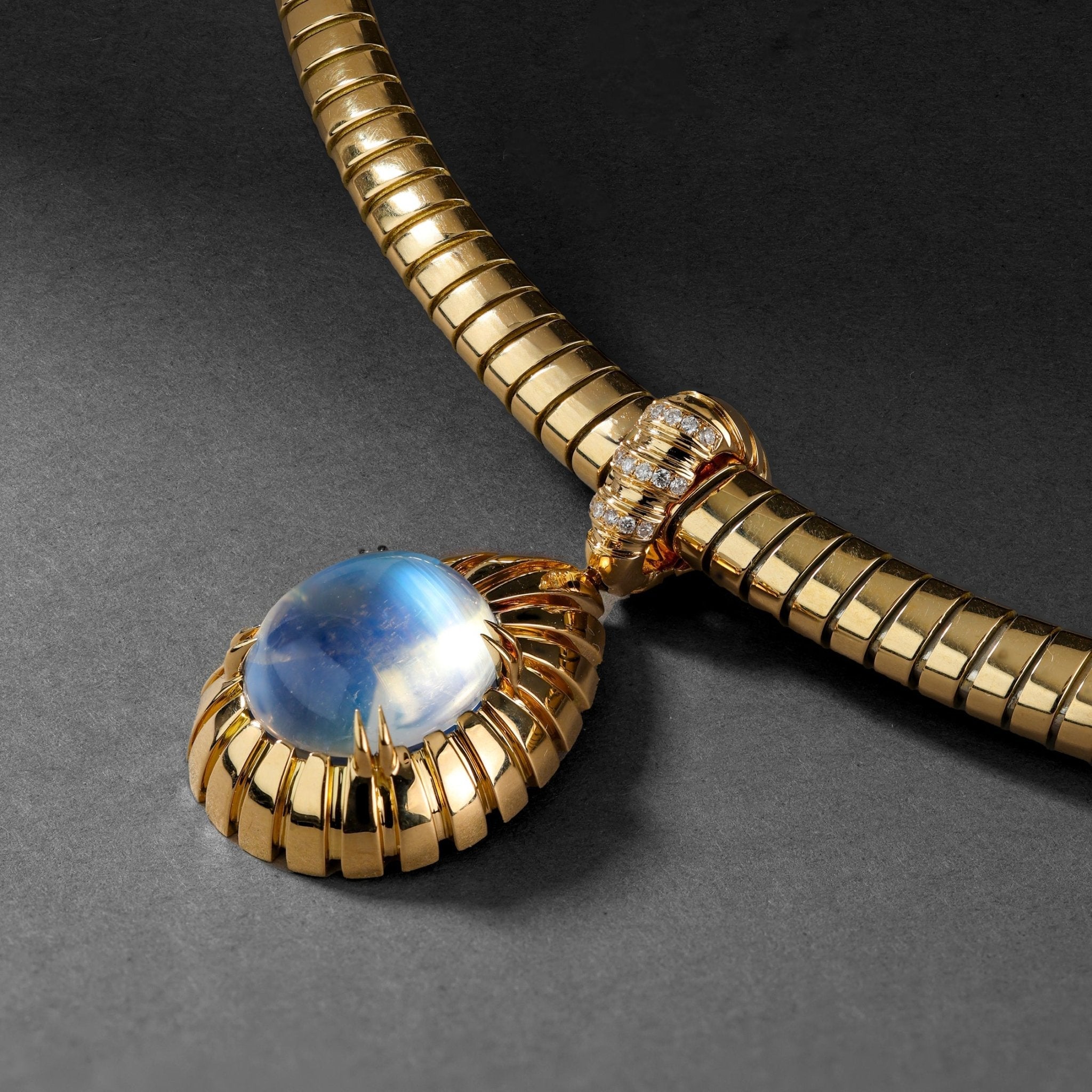[text]
If you’re like us, you’ve spent your life in awe of the moon. A timeless marvel, it holds a power that we learn about in textbooks and observe the night sky. There is nothing as magical or mystical as the shining light of the moon.
It is the subject of countless songs, poems, and symbols. It holds a particular mystery and magnificence to it, serving as a beacon of both hope and rejuvenation. With each passing phase, it adds or diminishes its body, only to be born again once more when the timing is right. Supermoons and harvest moons cause stirs worldwide as people race to capture the glow in photographs and telescopes.
Fine gems like alexandrite are typically easier to differentiate based on their value when it comes down to how well they are able to change their hues in different lighting. While it may seem simple that turquoise is primarily judged based on its color saturation, this understanding can become complicated. The truth may be obscured by imitation blues that have been floating around jewelry communities for decades.
What if we told you that you could hold that exact glow, not behind a filtered screen or up in the galaxy, but in your hand? What if we told you that it could become a part of your wardrobe?
Moonstone is one of the most beautiful gemstones. It gets its name from the moon due to its nearly identical appearance. At Mark Henry, we appreciate the splendor this stone brings to all who wear it, and we advocate for its inclusion in pieces from earrings to bracelets.
Before you know it, you’ll be equally enthralled with our moonstone collection just as much as you are with its namesake!
All About Moonstone
Moonstone is part of the feldspar-group mineral orthoclase and is made from feldspar minerals called albite and orthoclase. This highly-desired stone contains potassium aluminum silicate.
Moonstone was first found in the mines of Switzerland millennia ago. It was there in Mt. Adular that the precious gem was brought to light. Both Ancient Greeks and Ancient Romans took a liking to the adularia-rich finding.
[/text]
[text]

[/text]
Where Is Moonstone Found?
Since its initial discovery, moonstone has been found and mined across the world in various gravels and pegmatites. Some of the most coveted moonstones are sourced from Myanmar. These pieces of moonstone are colorless and have stunning clarity. The only hint of hue is their blue sheen, which is prized in all moonstones and reflects impeccably in these supplies.
If you want some locally-mined moonstone, you’re in luck. The United States actually has its own supply! You can find U.S. moonstones in New Mexico and Virginia, most notably. In Europe, miners hunt for moonstone in the Larvik Fjord Region of Norway.
Moonstone is also found in Brazil — the same country that produces some of the highest-quality alexandrite the Earth’s crust has to offer.
While the more-prized gems from Myanmar are low in supply, the demand never ceases, and the other mines pick up the slack.
Physical Features
Apart from its resemblance to the moon, this gem is a force in and of itself. It is a type of orthoclase and has an iconic, glassy luster. Moonstone has a refractive index of 1.518 to 1.525 and a specific gravity of 2.56 to 2.59.
It usually cleaves two ways exactly, although its fractures can be uneven. It doesn’t have multiple colors at once, so there is no pleochroism. This is not counting the blue sheen in colorless stones, however.
Colorful Combinations
Moonstone does have a luminescence that is fluorescent, UV-Long, and UV-Short. On the long wave luminescence, it is blue, but on the short wave, it is orange. Its fluorescence can be in warmer tones regardless of which wave it is on. This adds a tint or sheen to the stone (apart from the color of its body).
The gemstone also comes in a wide variety of colors thanks to its differing amounts of iron. Moonstone, while most prized for its clear and transparent appearance, can be green, red, pink, brown, yellow, orange, or even gray.
Adularescence
Feldspar is the driving force behind moonstone's adularescence, also known as its classic blue sheen. The stone can “shine” like the moon because it contains feldspar placed in layers that allow light to bounce in various directions.
Rainbow moonstone undergoes a similar effect called labradorescence. Its albite layers disperse light to give off numerous, colorful Schiller effects. However, the rainbow moonstone is not real moonstone, and the labradorescence of competing Schiller colors at once is not to be mistaken for the blue sheen of the real thing.
[row::moonstone-blog]
Inclusions and Blemishes
Moonstone is known for its inclusions. Most natural gemstones have inclusions, which separate them from their lab-created counterparts. Unlike other gemstones, moonstone is known for its inclusions in abundance.
For moonstone, the “centipede” lines inside it don’t take away from the value to the wearer. These are thin layers of small cracks in the stone. Some people like to watch these designs shimmer and opt to purchase pendants or rings with unique patterns on purpose.
The stress cracks can become a problem when they grow to be bigger than “centipedes.” These cracks create dark parts of the stone, which can inherently lower its value and deplete its shine.
Durability
Moonstone is a 6.5 on the Mohs Hardness Scale. This may come as a shock to some jewelry consumers who understand what this means. Most gemstones that rest this low on the scale are not deemed wearable. In fact, diamonds are a 10 on the scale (the highest ranking possible), and even they are prone to dents and scratches when worn.
However, the moonstone is so luxurious in appearance that it is treated to be worth it. You can request your moonstone crystal to receive a protective setting. This reduces your risk of scratches and dents but only goes so far. We recommend wearing moonstone in pieces like necklaces and earrings because they are not bumped around as often as everyday rings or bracelets are.
If you do choose to wear a moonstone ring, make sure to be careful with sudden movements. Avoid wearing the stone when doing manual labor, washing dishes, or bathing. The good news is that it is not sensitive to heat, but steaming devices still should not be used on it.
Clean and Careful
The best way to clean moonstone, and ensure its protection in the process, is to be incredibly gentle. Upkeep for moonstone includes wiping away debris and dirt frequently to maintain its transparent glow.
Brushes with gentle bristles can carefully buff away these blemishes. Warm water and soft soap should be used when necessary to get a deeper clean. Only wipe the moonstone with a cloth that is non-abrasive.
If you suspect your moonstone has been scratched, you can always bring it to a jeweler or a gemologist. Under proper magnification, these issues can be noted and potentially resolved. Inclusions and sheen can cloud the eye-clean view, so asking for help will never help to ensure there are no internal injuries to the piece.
Relation to the Moon
Moonstone is famed as one of the birthstones for June and symbolizes everything that is associated with the moon. As such, moonstones are often discussed in relation to fertility, feminine energy, and hope.
The stone is also thought to have healing properties; those supposed healing powers cause some to wear moonstone to ward off negative energy.
White moonstone and blue moonstone are both typically cut in a cabochon shape. When polished, moonstones of this pearly shape display chatoyancy, also known as the “cat’s eye” effect. Due to the distinct look of cabochon moonstones, they became popular during the Art Nouveau period in Europe.
The stone is also thought to have healing properties; those supposed healing powers cause some to wear moonstone to ward off negative energy.
In some cultures, moonstone is still processed along with the moon's phases, as Pliny believed. The gem is thought to be at its highest vibrational frequency when there is a new or full moon.
Some people place it on their windowsill to charge in the glow of its namesake, just like one would charge moon water. These practices are thought to heal and cleanse the stone and, by relation, its owner.
Feng Shui
Moonstone is also used in Feng Shui practices and is thought to have similar healing strength. It is associated with femininity. While the “man in the moon” iconography will always be popular, there is something inherently maternal about the moon as well. Feng Shui seeks to harness this power.
If a piece of moonstone rests underneath wherever you sleep, it is believed that you will become more open to the world and your own feelings. Practitioners believe that a piece of moonstone carefully placed in a bedroom can heal interpersonal relationships. Placing moonstone where you work (a home office or at your job site) may produce innovation and bring about new ideas.
Why Moonstone?
Moonstone is loaded with connections to the natural world, and there are hardly any stones that capture our imagination quite so fiercely.
It mixes a gemstone reality with tales untold of the greater Milky Way that we inhabit, toeing the line between fact and potential fiction. We’re willing to bet that moonstone shines just as bright as the stars that its namesake rotates around every night!
Sources:
What is Moonstone Gemstone? Value, Price, and Color | Gem Society
Imitation Rainbow Moonstone Assemblage | Gems & Gemology
The Meaning of Moonstone and How to Use It with Feng Shui | The Spruce


